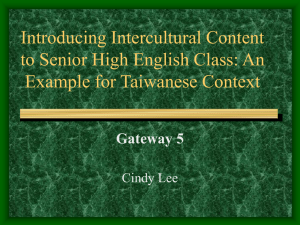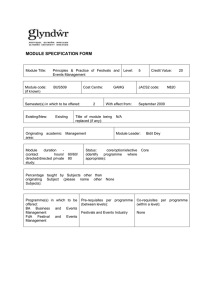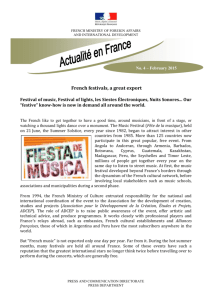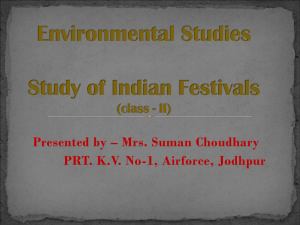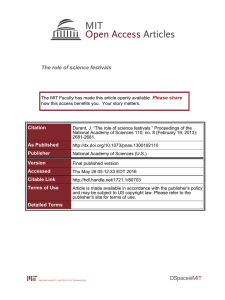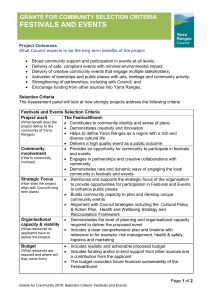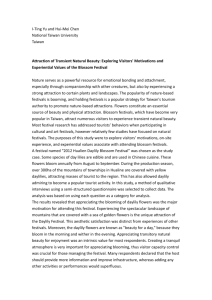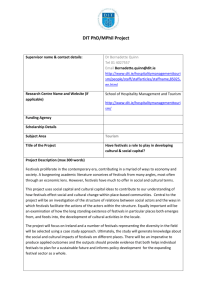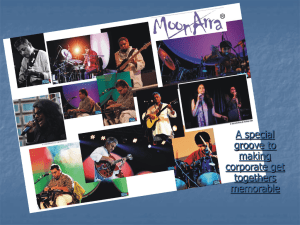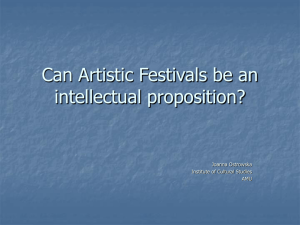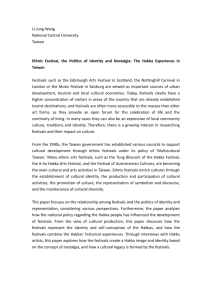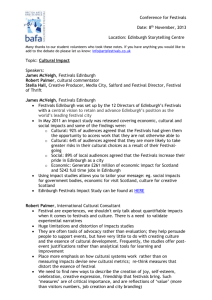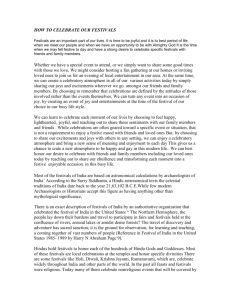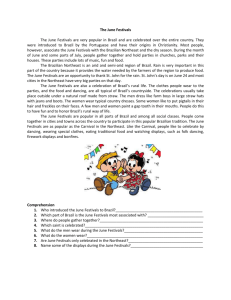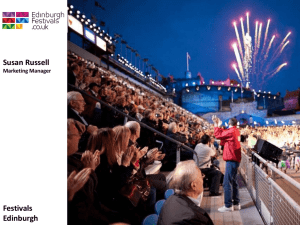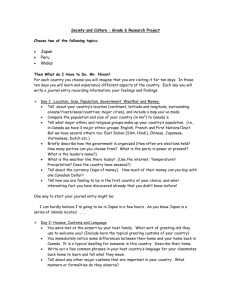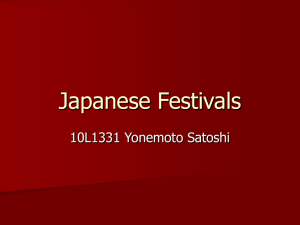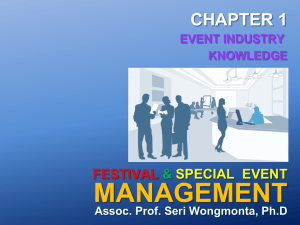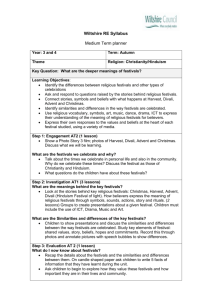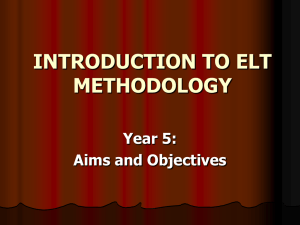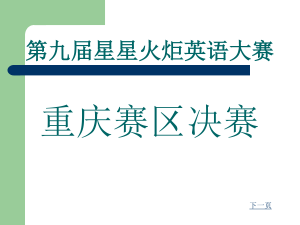Conor-Mc-Tiernan
advertisement
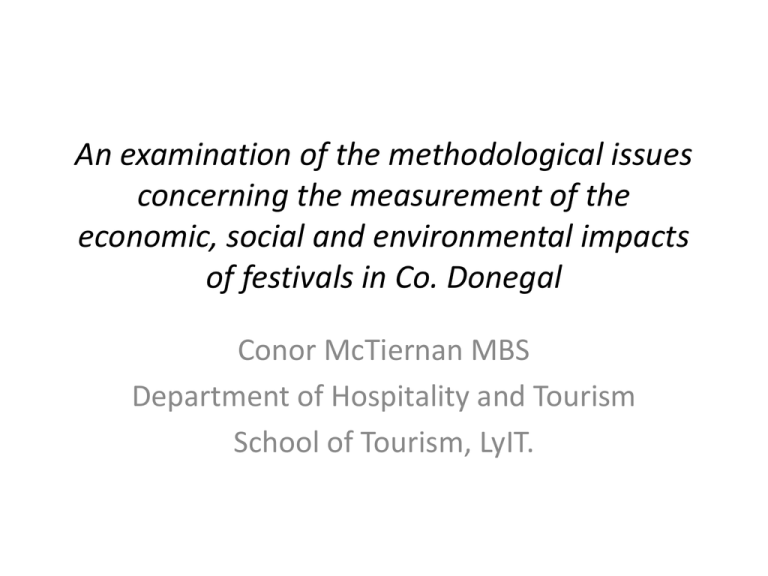
An examination of the methodological issues concerning the measurement of the economic, social and environmental impacts of festivals in Co. Donegal Conor McTiernan MBS Department of Hospitality and Tourism School of Tourism, LyIT. Presentation Overview • • • • • • • Background to festivals and events Festival and event evaluation Methodology Questionnaire design Survey distribution Sample size Potential outcomes Festivals and Events • Falassi (1987, pp.2) defined festivals as “a sacred or profane time of celebration, marked by special observances” stressing the anthropological dimension of many events around the world. • Getz, defines festivals as “themed public celebrations” (1997, pp.21). Why embrace festivals and events? • Economic injection and potential multiplier effect. • Increase and extend visitor numbers; during festival and future visits. • Catalyst for development; physically and culturally. • Host community enhancement. Growth and development of Festivals and Events • Phenomenal increase in number and thematic diversity of festivals and events in Ireland. • Attracts domestic and international visits to a destination. • Complements tourist markets requirements. • Commercial and community/ urban and rural. • Is there an over supply? • Are they all viable? • Festival organisation support and management. Festival evaluation • Could be considered a burgeoning field for Ireland. • Economic impact analysis a key focus. • Economic evaluation: Jackson et al (2005) computable general equilibrium (CGE) models, input-output analysis, cost benefit analysis. • Lack of International standard. Input-output analysis ideal for transient, small regional festivals (ibid). Problems • Crompton and McKay (1994): use of sales rather than income multipliers, misrepresentations of employment multipliers, inclusion of local residents failure to exclude ‘time-switchers’ and ‘casuals’. • Economic impacts assessment fail to noneconomic benefits and costs. Development of sustainable tourism • Dwyer (2000) suggested that such events have economic costs and benefits but also social costs and benefits. • Hede (2007) contended festivals and events evaluation should be based on the triple bottom line (TBL). • Deery and Jago (2010) social impact theories: Social exchange Social representation Growth machine. Environmental impacts • Lack of academic literature. • Juxtaposed with an increase in demand from practitioners and attendees for guidelines and solutions. • Kearins and Pavlovich’s 2002 case study of the Sydney Olympic Games and Carlsen and Taylor’s 2003 study of the Manchester Commonwealth Games. • Australia’s Sustainable Tourism Cooperative Research Centre’s (STCRC). Methodology • Wood’s 2005 measurement of social and economic impacts of local authority events suggests development of six questionnaires; 1. Pre event host attitudinal survey, 2. Festival attendees survey, 3. Host community non-attendees survey, 4. Post event local business survey, 5. Post event sponsor and community group survey, 6. Post event host attitudinal survey. Methodology • Jackson et al (2005) analysed the STCRC’s Festival DIY kit - uses standard questionnaires and this counteracts the contention that there is a lack of a standardised set of criteria for evaluating the economic impact of a festival. Questionnaire design • The objectives of the surveys: 1. Gather data which can be combined with other information to evaluate the festival or events net economic gain to the host community, 2. Assess the effect, if any, on the host communities attitude to the festival, 3. Measure the environmental impact of the festival on the host and regional communities. Questionnaire design • Definition of Local/ host/ resident – resides within 10km of venue if rural and 5km if urban. • Income rather than sales multiplier calculated by assessing percentage of income and expenditure at local level. • Environmental impacts - collection of data on travel and transport by type and distance, accommodation usage by type and duration and refuse disposal by type and volume. A carbon and water footprint can be calculated using up to date national statistics provided by the Environmental Protection Agency (EPA). Questionnaire design • Host community residents - same questionnaire is used so that any changes in perceptions can measured. • Use of Likert scale as supported by Fredline and Faulkner (2000) and Deery and Jago (2010). • Three point Likert. Distribution • Wright (2005) - previous decade had witnessed a ‘tremendous increase in internet use and computermediated communication’. Supports on-line surveys. • Advantages: Reach participants directly, automated data collection, reduction financial and time costs (ibid, 2005) completed at the convenience of the respondent (Sax, Gilmartin and Bryant, 2003). • Disadvantages: uncertainty over the validity of the data and sampling issues (Wright, 2005), accessing the appropriate population (Hudson and Bruckman, 2004) and the challenge of designing, implementing and evaluating an online survey. Sample size • Lack of international standard. • Wood’s Blackburn study (2005) 100% local business for economic impacts and 150 structured telephone interviews (Population predefined) for social impacts. • Deery and Jago (2010) Australian Open Tennis (600,000 patrons) 197 randomly selected participants for structured telephone interviews. • Maughan and Bianchini (2004) 4704 responses from 250,000 audience members at eleven festivals in the English East Midlands region 1.9% sample size. Potential findings and outcomes • Benefits to stakeholders – small number of local businesses. • Residents perceptions – influenced by timing, congestion, anti-social behaviour etc. • Environmental impacts – greater than expected • Survey design and distribution – nature of data and online distribution. • Encourage adoption of international best practice and encourage stakeholders to consider impacts of festivals and events. • Potential to broaden study to include range of events, assess impacts of marketing, assess pre and post event perceptions of attendees.

